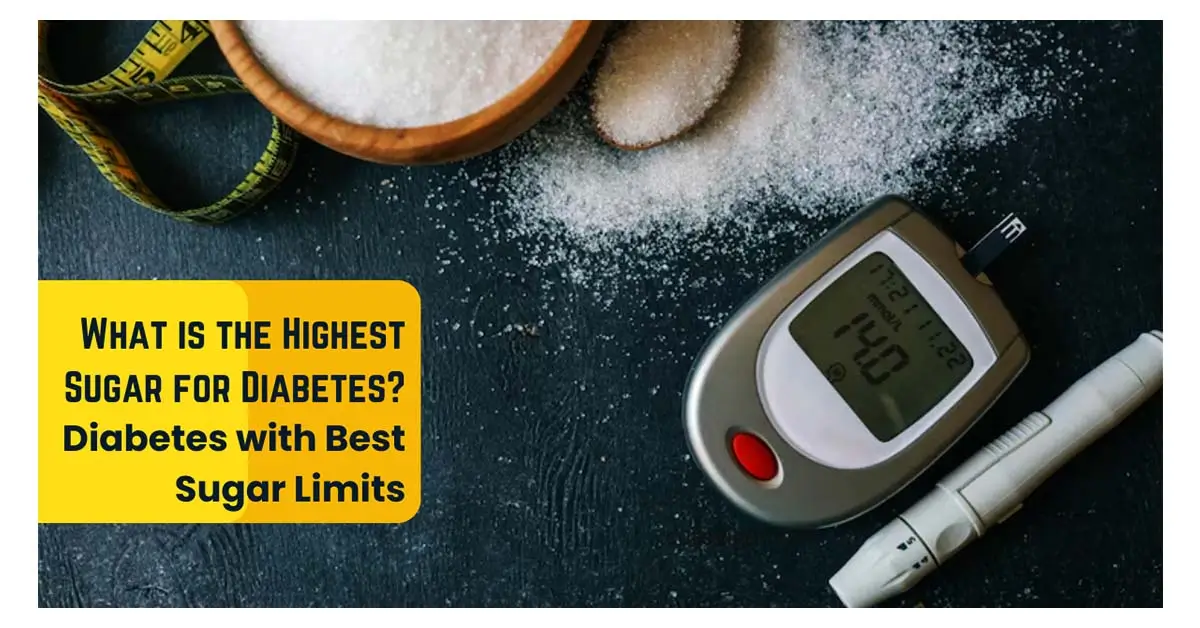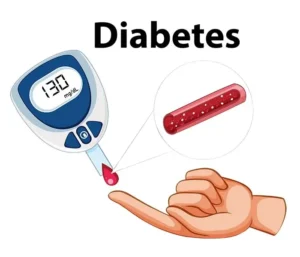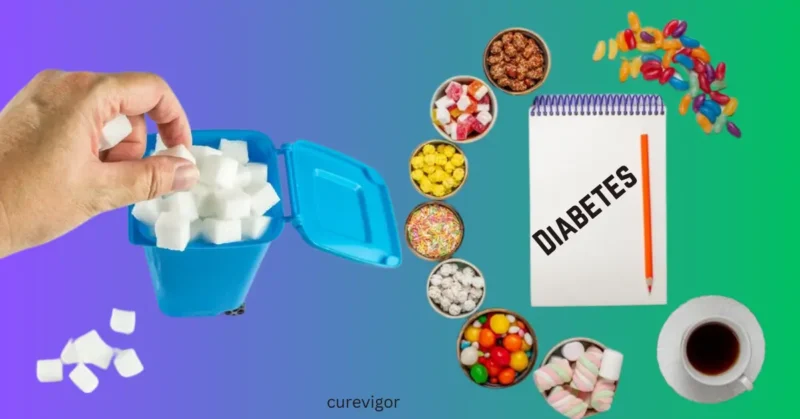Understanding Sugar in Diabetes: Recognize the Boundaries! Discover how to manage diabetes with the best sugar limits. Seize Control of Your Health Now.
Thank you for reading this post, don't forget to subscribe!How to Manage Diabetes with the Best Sugar Limits
Diabetes is a chronic medical condition characterized by elevated blood sugar levels due to insulin dysfunction. It affects millions of people worldwide and can lead to severe health complications if not managed properly.
This article explores the impact of sugar consumption on diabetes management and focuses on determining a safe maximum sugar intake for diabetics.
Diagnosing Diabetes:
Diabetes has different types, the most common being Type 1 and Type 2. Type 1 diabetes is an autoimmune condition in which the body’s immune system attacks the insulin-producing cells in the pancreas. Type 2 diabetes, on the other hand, occurs when the body becomes resistant to insulin or does not produce enough insulin to regulate blood sugar levels effectively.
To avoid consequences, including heart disease, neurological damage, and renal issues, managing diabetes necessitates careful monitoring of blood sugar levels.
Effects of High Sugar Intake:
Consuming excessive amounts of sugar can result in sharp increases in blood sugar, which puts additional strain on the body’s insulin response. A high-sugar diet is strongly associated with an increased risk of Type 2 diabetes. Additionally, individuals who often consume sweets may struggle to maintain their blood sugar levels, leading to more frequent changes.
Understanding Glycemic Index:
The glycemic index (GI) is a scale that ranks foods based on how quickly they raise blood sugar levels. Foods with a high GI cause rapid spikes in blood sugar, while low-GI foods result in more gradual increases. Focusing on eating low-GI foods is essential for individuals to support stable blood sugar levels.
Recommended Sugar Limits for Diabetics:
The American Diabetes Association advises patients to restrict their regular sugar consumption. The recommended daily intake for added sugar is six teaspoons (25 grams) for women and nine teaspoons (36 grams) for men. This contains naturally occurring sugars in food and added sugars in prepared and processed foods.
Strategies for Managing Sugar Intake:
Reducing sugar consumption can be challenging, but is essential for diabetes management. Some practical strategies include:
- Opting for sugar-free or low-sugar alternatives in beverages and foods.
- Reading food labels to identify hidden sugars in products.
- Using natural sweeteners like stevia or monk fruit extract.
- Limiting the consumption of sugary desserts and treats.
Sugar and Diabetes Medication:
For individuals taking diabetes medication, managing sugar intake is critical to avoid potential complications. High sugar levels can interfere with the effectiveness of insulin and other diabetes drugs, leading to unstable blood sugar control. Therefore, it’s vital to coordinate sugar intake with the prescribed medication.
Balancing Carbohydrates and Sugar:
Carbohydrates directly affect blood sugar levels as they break down into glucose during digestion. To keep their blood sugar levels consistent, diabetics must be aware of their sugar and carbohydrate intake. Selecting complex carbs and pairing them with lean proteins and healthy fats is crucial for better glycemic control.
The Role of Exercise in Sugar Management:
Diabetes management involves physical activity. Exercise enhances the body’s ability to utilize glucose, improving blood sugar regulation. Regular physical activity also promotes weight management, crucial for controlling and preventing Type 2 diabetes.
The following are a few exercises:
1. Brisk Walking
Description: Brisk walking is a simple yet effective aerobic exercise that helps manage blood sugar levels. It enhances insulin sensitivity and aids in weight management, both crucial for sugar control.
How to Perform:
- Warm-Up: Start with a 5-minute warm-up of light walking to prepare your muscles.
- Pace: Increase your pace to a brisk walk, maintaining a speed where you can talk but not sing comfortably.
- Duration: Aim for 30-60 minutes of brisk walking at least 5 days a week.
- Cool Down: End with a 5-minute cool-down of light walking and gentle stretching.
Tips:
- Wear comfortable walking shoes.
- Walk in a safe, well-lit area.
- Track your progress using a pedometer or a walking app.
2. Strength Training
Description: Strength training, including weight lifting or resistance exercises, helps build muscle mass, which improves insulin sensitivity and glucose uptake by the muscles.
How to Perform:
- Warm-Up: Begin with 5-10 minutes of light cardio, like walking or jogging in place.
- Exercises:
- Squats: 3 sets of 10-12 reps
- Dumbbell Rows: 3 sets of 10-12 reps per arm
- Push-Ups: 3 sets of 10-15 reps
- Bicep Curls: 3 sets of 12-15 reps
- Tricep Dips: 3 sets of 10-12 reps
- Cool Down: Finish with 5-10 minutes of stretching to prevent muscle soreness.
Tips:
- Use challenging weights, yet allow yourself to complete the reps in the proper form.
- Rest for 1-2 minutes between sets.
- Strength training exercises should be performed at least 2-3 times weekly.
3. Yoga
Description: Yoga combines physical postures, breathing exercises, and meditation, helping reduce stress and manage blood sugar levels. It enhances overall physical and mental well-being.
How to Perform:
- Warm-Up: Begin with gentle stretches to prepare your body.
- Yoga Poses:
- Cat-Cow Stretch: 5-10 rounds to improve spine flexibility
- Downward-Facing Dog: Hold for 5-10 breaths to strengthen arms and legs
- Warrior II: Hold for 5-10 breaths per side to enhance balance and strength
- Tree Pose: Hold for 5-10 breaths per side to improve balance
- Seated Forward Bend: Hold for 10-15 breaths to stretch the back and legs
- Breathing Exercises: Practice deep breathing or pranayama for 5-10 minutes to relax the mind and body.
- Cool Down: End with a 5-10 minute relaxation pose, such as Savasana (Corpse Pose), to calm the nervous system.
Tips:
- Practice yoga 3-5 times a week.
- Focus on your breath and maintain a mindful approach to each pose.
- Consider joining a yoga class or following an online video for guided instruction.
Sugar and Diabetic Recipes:
Plenty of sugar-free and low-sugar recipes are available for those with a sweet tooth. Those with diabetes can enjoy desserts made with alternative sweeteners like erythritol or xylitol, providing a guilt-free way to satisfy cravings.
Following are a few recipes:
1. Baked Salmon with Avocado Salsa
Ingredients:
- Four salmon fillets
- Two tablespoons of olive oil
- Salt and pepper to taste
- Two avocados, diced
- One small red onion, finely chopped
- One jalapeño, seeded and finely chopped
- 1/4 cup fresh cilantro, chopped
- Juice of 2 limes
- One clove of garlic, minced
Instructions:
- Preheat Oven: Preheat your oven to 375°F (190°C).
- Prepare Salmon: Place the salmon fillets on a baking sheet. Drizzle with olive oil and season with salt and pepper.
- Bake Salmon: Bake in the oven for 15-20 minutes or until the salmon flakes easily with a fork.
- Make Salsa: In a bowl, combine the diced avocados, red onion, jalapeño, cilantro, lime juice, and minced garlic. Mix gently.
- Serve: Spoon the avocado salsa over the baked salmon fillets and serve immediately.
2. Quinoa and Vegetable Stir-Fry
Ingredients:
- 1 cup quinoa
- 2 cups vegetable broth
- 2 tablespoons olive oil
- 1 bell pepper, sliced
- 1 zucchini, sliced
- 1 cup broccoli florets
- 1 carrot, julienned
- 1 small onion, sliced
- 2 cloves of garlic, minced
- 2 tablespoons of low-sodium soy sauce
- 2 tablespoons of sesame oil
- 2 teaspoons of grated ginger
- 1/4 cup chopped fresh parsley
Instructions:
- Cook Quinoa: Rinse the quinoa under cold water. Combine the quinoa and vegetable broth in a pot. Bring to a boil, reduce heat, cover, and simmer for 15 minutes or until the quinoa is tender and the liquid is absorbed.
- Stir-Fry Vegetables: Heat olive oil over medium-high heat in a large pan or wok. Add garlic and ginger, and sauté for 1 minute. Then, add the bell pepper, zucchini, broccoli, carrot, and onion. Stir-fry for 5-7 minutes until the vegetables are tender-crisp.
- Combine: Add the cooked quinoa to the pan with the vegetables. Pour in the soy sauce and sesame oil. Stir well to combine and heat through.
- Serve: Garnish with chopped parsley and serve hot.
3. Greek Yogurt Parfait with Berries and Nuts
Ingredients:
- 2 cups plain Greek yogurt
- 1 cup mixed berries (blueberries, strawberries, raspberries)
- 1/4 cup chopped nuts (almonds, walnuts, pecans)
- One tablespoon of chia seeds
- One teaspoon of vanilla extract
- One tablespoon of honey (optional, or a sugar substitute like stevia)
- Fresh mint leaves for garnish (optional)
Instructions:
- Prepare Yogurt: In a bowl, mix Greek yogurt with vanilla extract and honey (if using).
- Layer Parfait: In glasses or bowls, layer Greek yogurt, mixed berries, chopped nuts, and chia seeds.
- Garnish: Garnish with fresh mint leaves if desired.
- Serve: Serve immediately or refrigerate for a refreshing treat later.
The Psychological Aspect of Sugar Management:
Adhering to dietary restrictions can be emotionally challenging for individuals, particularly those living with diabetes. The necessity of monitoring sugar intake often leads to feelings of deprivation, especially when it comes to sweet treats and desserts, which are typically associated with celebration and comfort. This sense of longing can result in frustration, disappointment, and even stress, potentially affecting overall mental and emotional well-being.
Individuals with diabetes need to develop coping strategies tailored to their unique requirements in order to manage these challenges effectively. These strategies may include finding healthy alternatives to traditional sweets, exploring non-food-related rewards, or engaging in activities that foster a sense of fulfillment and joy.
Additionally, seeking support from friends, family, or diabetes support groups can provide encouragement and a shared understanding of these emotional struggles. Building a strong support network and developing proactive coping strategies can help individuals maintain a positive outlook while effectively managing their dietary needs and sugar intake.
Frequently Asked Questions:
Q. What are the limits of sugar levels?
The normal blood sugar levels are typically defined as:
- Fasting blood sugar (before eating): 70-99 mg/dL (3.9-5.5 mmol/L)
- Postprandial blood sugar (2 hours after eating): less than 140 mg/dL (7.8 mmol/L)
Blood sugar levels outside these ranges may indicate a problem and warrant further investigation by a healthcare professional.
Q. What is the sugar limit for diabetes?
For individuals with diabetes, the American Diabetes Association suggests the following blood sugar targets:
- Fasting blood sugar: 80-130 mg/dL (4.4-7.2 mmol/L)
- Postprandial blood sugar (2 hours after eating): less than 180 mg/dL (10.0 mmol/L)
Adhering to these targets can aid in effectively managing diabetes and lowering the risk of complications.
Q. What is the perfect sugar level for a person with diabetes?
A well-managed diabetic should aim for blood sugar levels within the following ranges:
- Fasting blood sugar: 80-130 mg/dL (4.4-7.2 mmol/L)
- Postprandial blood sugar (2 hours after eating): less than 180 mg/dL (10.0 mmol/L)
These targets help maintain good health and prevent complications.
Q. What is the highest diabetes sugar level?
Extremely high blood sugar levels, such as those exceeding 240 mg/dL (13.3 mmol/L), can be dangerous and may require immediate medical attention. Prolonged high blood sugar levels can lead to complications such as diabetic ketoacidosis (DKA) or hyperosmolar hyperglycemic state (HHS), which are medical emergencies.
Q. What is a good sugar limit per day?
For a healthy diet, it is recommended to limit added sugars to:
- Men: No more than 36 grams (9 teaspoons) per day
- Women: No more than 25 grams (6 teaspoons) per day.
Following the above guidelines can help reduce the risk of obesity, heart disease, and diabetes.
Q. Which sugar is best for people with diabetes?
For individuals with diabetes, natural sweeteners like stevia and monk fruit are often recommended because they do not raise blood sugar levels. Artificial sweeteners such as aspartame, sucralose, and saccharin can also be used in moderation. To manage blood glucose levels effectively, it’s best to avoid refined sugars and high-fructose corn syrup. Always consult with a healthcare professional before making significant changes to your diet.
Conclusion
Understanding the relationship between sugar consumption and diabetes control is essential for people with diabetes. By adhering to suggested sugar limits, eating healthily, exercising regularly, and seeking help, people with diabetes can successfully manage their blood sugar levels and enhance their overall quality of life.
Read more articles about Health & Wellness.
You might like:




